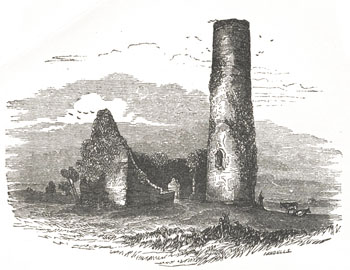Tighearnmas

Round Tower at Dysart, near Croom, Limerick
Tighearnmas—His Death—Introduces Colours as a Distinction of Rank—Silver Shields and Chariots first used—Reign of Ugaine Mor—The Treachery of Cobnthach—Romantic Tales—Queen Mab—Dispute which led to the celebrated Cattle Spoil—The Story of the Tain bo Chuailgne—The Romans feared to invade Ireland—Tacitus—Revolt of the Attacotti—Reign of Tuathal—Origin of the Boromean Tribute.
[B.C. 1700.]

UR annals afford but brief details from the time of Eremon to that of Ugainé Môr. One hundred and eighteen sovereigns are enumerated from the Milesian conquest of Ireland (according to the Four Masters, B.C. 1700) to the time of St. Patrick, A.D. 432. The principal events recorded are international deeds of arms, the clearing of woods, the enactment of laws, and the erection of palaces.
Tighearnmas, one of these monarchs, is said to have introduced the worship of idols into Ireland. From this it would appear, that the more refined Magian, or Sun-worship, had prevailed previously. He died, with "three-fourths" of the men of Ireland about him, on the night of Samhain,[9] while worshipping the idol called Crom Cruach, at Magh Slacht, in Breifné.[1] Tighearnmas reigned seventy-five years. He is said to have been the first who attempted the smelting of gold in Ireland; and the use of different colours,[2] as an indication of rank, is also attributed to him.
Silver shields were now made (B.C. 1383) at Airget-Ros, by Enna Airgtheaoh, and four-horse chariots were first used in the time of Eoitheachtaigh, who was killed by lightning near the Giant's Causeway. Ollamh Fodhla (the wise or learned man) distinguished himself still more by instituting triennial assemblies at Tara. Even should the date given by the Four Masters (1317 B.C.) be called in question, there is no doubt of the fact, which must have occurred some centuries before the Christian era; and this would appear to be the earliest instance of a national convocation or parliament in any country. Ollamh Fodhla also appointed chieftains over every cantred or hundred, he constructed a rath at Tara, and died there in the fortieth year of his reign.
Notes
[9] Samhain.—Now All Hallows Eve. The peasantry still use the pagan name. It is a compound word, signifying "summer" and "end."
[1] Breifné ;.—In the present county Cavan. We shall refer again to this subject, when mentioning St. Patrick's destruction of the idols.
[2] Colours.—Keating says that a slave was permitted only one colour, a peasant two, a soldier three, a public victualler five. The Ollamh ranked with royalty, and was permitted six—another of the many proofs of extraordinary veneration for learning in pre-Christian Erinn. The Four Masters, however, ascribe the origin of this distinction to Eochaidh Eadghadhach. It is supposed that this is the origin of the Scotch plaid. The ancient Britons dyed their bodies blue. The Cymric Celts were famous for their colours.
